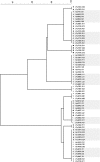Sequence-based typing of Mycoplasma genitalium reveals sexual transmission
- PMID: 16757601
- PMCID: PMC1489459
- DOI: 10.1128/JCM.00003-06
Sequence-based typing of Mycoplasma genitalium reveals sexual transmission
Abstract
Mycoplasma genitalium causes male nonchlamydial, nongonococcal urethritis and is associated with cervicitis and pelvic inflammatory disease in women. Epidemiological studies indicate that M. genitalium is sexually transmitted, and the aim of the present study was to further substantiate this by means of a DNA typing system. A typing assay based on a diagnostic mgpB gene PCR was developed, evaluated, and applied directly to urogenital specimens. The assay had a low limit of detection and hence a high typeability. Sequences of isolates from 52 unrelated patients were divided into 29 different sequence types, giving a discriminatory index of 0.95. Two to six M. genitalium-positive specimens were collected from each of 44 patients over a median interval of 56 days (range, 11 to 1,395). Forty had the same sequence type in consecutive specimens. Specimens collected from two men were repeatedly positive at intervals of 472 and 1,395 days, respectively, but the sequence types had changed. A new strain was introduced in one sexual dyad, and the sequence types changed subsequently. Seventy-nine M. genitalium-positive specimens from 19 couples were investigated, and all partners initially had concordant sequence types, but one couple had discordant types at one time point before a newly introduced strain took over. The present typing system is simple and reproducible and has an excellent discriminatory capacity which might prove useful in studies of sexual networks and for evaluation of treatment failures. In the laboratory, this system may document the uniqueness of newly isolated M. genitalium strains.
Figures


References
-
- Anagrius, C., and B. Loré. 2002. Klamydialiknande symptom kan ha annan bakgrund—Mycoplasma genitalium—en viktig och vanlig STD. Läkartidningen 99:4854-4859. - PubMed
-
- Clausen, H. F., J. Fedder, M. Drasbek, P. K. Nielsen, B. Toft, H. J. Ingerslev, S. Birkelund, and G. Christiansen. 2001. Serological investigation of Mycoplasma genitalium in infertile women. Hum. Reprod. 16:1866-1874. - PubMed
-
- Cohen, C. R., L. E. Manhart, E. A. Bukusi, S. Astete, R. C. Brunham, K. K. Holmes, S. K. Sinei, J. J. Bwayo, and P. A. Totten. 2002. Association between Mycoplasma genitalium and acute endometritis. Lancet 359:765-766. - PubMed
Publication types
MeSH terms
Grants and funding
LinkOut - more resources
Full Text Sources

